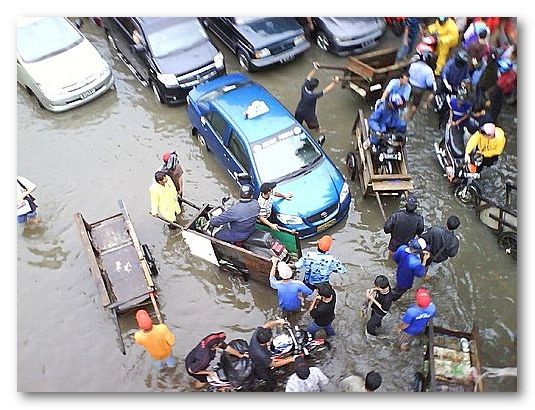Jakarta needs more green space, but not at the expense of the poor
By Deden Rukmana

What happens when you destroy green spaces: Jakarta in flood in 2008
Luis Ruay
Jakarta is not only Indonesia’s capital and most dynamic city, it is also beset with a plethora of 21st century urban problems. As its population grows, its green spaces shrink. In the first half of the twentieth century Batavia, colonial capital of the Netherlands East Indies, was a small urban area with approximately 150,000 residents. Batavia has become Jakarta, Indonesia’s megacity of 14 million.
Green spaces in the city have shrunk along with this leap in population. As recently as 1965, green areas made up more than 35 per cent of Jakarta’s land area. Currently, they account for only 9.3 per cent, far below the target of 30 per cent set by Law No 26 of 2007 on Spatial Planning.
Shrinking green areas
As Jakarta is certain to continue to grow, the city’s master plan to protect remaining green spaces and add some more, especially along riversides, offer some hope. The city’s current 2000-2010 master plan aims to achieve green areas (legally defined as areas where plants can grow) of 13.94 per cent of the total city area. This is an excellent goal, but it is modest when we compare it to similar plans in the past. The 1965-1985 master plan, for example, planned for green areas covering 27.6 per cent of Jakarta’s land area. In part, these plans are simply catching up with reality. New luxury homes, condominiums, shopping malls, hotels, commercial buildings and offices have proliferated in Jakarta over the last three decades. Many have been built at the expense of green areas and have paved over water catchment areas, making the city more prone to floods
Not surprisingly, annual floods are becoming more severe, and more deadly. The worst flood in memory occurred in February 2007, inundating about 70 per cent of the city. It killed at least 57 people and sent some 450,000 fleeing their homes. In the aftermath of the flood, Environment Minister Rachmat Witoelar put the blame on excessive construction of residential and commercial buildings, which now cover many of the city’s former green areas.
Annual floods in Jakarta point to an urgent need to protect existing green areas in the capital – and to create new ones. Green areas absorb rainwater and thus help prevent flooding. Green areas also help make cities more sustainable and livable.
Clearing out the poor
Inside Indonesia
